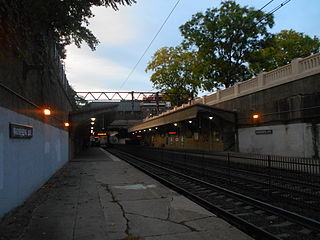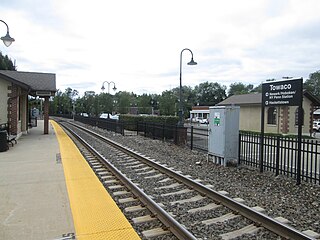
The Delaware, Lackawanna and Western Railroad, also known as the DL&W or Lackawanna Railroad, was a U.S. Class 1 railroad that connected Buffalo, New York, and Hoboken, New Jersey, and by ferry with New York City, a distance of 395 miles (636 km). Incorporated in Pennsylvania in 1853 primarily for the purpose of providing a connection between the anthracite coal fields of Pennsylvania's Coal Region and the large markets for coal in New York City. The railroad gradually expanded both East and West, eventually linking Buffalo with New York City.

The Main Line is a commuter rail line owned and operated by New Jersey Transit running from Suffern, New York to Hoboken, New Jersey, in the United States. It runs daily commuter service and was once the north–south main line of the Erie Railroad. It is colored yellow on NJ Transit system maps, and its symbol is a water wheel.

NJ Transit Rail Operations is the rail division of NJ Transit. It operates commuter rail service in New Jersey, with most service centered on transportation to and from New York City, Hoboken, and Newark. NJ Transit also operates rail service in Orange and Rockland counties in New York under contract to Metro-North Railroad. The commuter rail lines saw 45,838,200 riders in 2022, making it the third-busiest commuter railroad in North America and the longest commuter rail system in North America by route length.

The Morristown Line is an NJ Transit commuter rail line connecting Morris and Essex counties to New York City, via either New York Penn Station or Hoboken Terminal. Out of 60 inbound and 58 outbound daily weekday trains, 28 inbound and 26 outbound Midtown Direct trains use the Kearny Connection to Penn Station; the rest go to Hoboken. Passengers can transfer at Newark Broad Street or Summit to reach the other destination. On rail system maps the line is colored dark green, and its symbol is a drum, a reference to Morristown's history during the American Revolution.
The Morris and Essex Railroad was a railroad across northern New Jersey, later part of the main line of the Delaware, Lackawanna and Western Railroad.

Newark Broad Street station is a New Jersey Transit commuter rail and light rail station at 25 University Avenue in Newark, New Jersey. Built in 1903, the station's historic architecture includes an elegant clock tower and a brick and stone façade on the station's main building. In June 1984, the station was added to the National Register of Historic Places in recognition of its historical significance.

Denville is an active commuter railroad train station in Denville Township, Morris County, New Jersey. Located on Estling Road, the station contains three side platforms–two curved low-level platforms that service New Jersey Transit's Morristown Line, and a third that services their Montclair-Boonton Line. Both platforms on the Morristown Line contain miniature high-level platforms for handicap accessibility. Trains on both lines operate between Hoboken Terminal, New York Penn Station and Hackettstown. Heading westbound, the next station is Dover while the next station east on the Morristown Line is Mount Tabor. The next station east on the Montclair-Boonton Line is Mountain Lakes.

Dover is an active commuter railroad train station in the borough of Dover, Morris County, New Jersey. Located at the end of electric service, Dover station serves as a secondary terminal of NJ Transit's Morristown and Montclair-Boonton Lines. Non-electric service continues west to Hackettstown on both lines. The next station to the west is Mount Arlington while the next station to the east is Denville. Dover station consists of a single island platform, accessible for the handicapped.

Netcong is an NJ Transit station in Netcong, in Morris County, New Jersey, United States. Located on Route 46 at Main Street in downtown Netcong, the small, 1-low level side platform station service passengers for the Morristown Line and the Montclair-Boonton Line. These lines provide service to Hoboken or to New York City via Midtown Direct on the Morristown Line at Dover station and Montclair-Boonton at Montclair State University station. Midtown Direct service can also be transferred at Newark Broad Street station in Newark. There is one track and one platform on the north side, adjacent to the station. NJ Transit maintains a substantial train servicing yard east of the Netcong station at Port Morris in Roxbury Township. Port Morris Yard is proposed to return as the junction of the Montclair-Boonton and Morristown lines for the Lackawanna Cut-Off line to Scranton. Transfers would be provided at Lake Hopatcong station in Landing.

Mount Olive is a NJ Transit station in Mount Olive, New Jersey, located in the International Trade Center. The station, located on the side of Waterloo Village Road, services trains for both the Montclair-Boonton Line and the Morristown Line along trackage owned by Norfolk Southern. The line is not electrified from Hackettstown to Dover, where passengers can transfer to an electric Morristown Line train via Summit or a diesel Montclair-Boonton train via Wayne and Montclair. Trains along both lines head to Hoboken Terminal in Hoboken, New Jersey or New York Penn Station at 34th Street in New York City, although Montclair-Boonton trains require a transfer at Montclair State University or Newark Broad Street for electrified service to New York. It is also the least-used station in the NJ Transit commuter rail network.

Watsessing Avenue station is a New Jersey Transit rail station in Bloomfield, New Jersey, along the Montclair-Boonton Line. It is located beneath the Bloomfield Police Benevolent Association meeting hall near the corner of Watsessing Avenue and Orange Street in Bloomfield. It is one of two stations on the line where the boarding platform is below ground level. The Watsessing station and the Kingsland station in Lyndhurst on the Main Line shared similar designs and were built about the same time.

Mountain View, signed on the platform as Mountain View–Wayne, is a station on the Montclair-Boonton Line of NJ Transit in Wayne, New Jersey. Prior to the Montclair Connection in 2002, the station was served by the Boonton Line. The station is located on Erie Avenue, just off of US 202 and Route 23 in Downtown Wayne. Since January 2008, Mountain View station is the second of two stations in Wayne, the other being the Wayne Route 23 Transit Center, a station off the Westbelt interchange.

Lincoln Park is a station on NJ Transit's Montclair-Boonton Line in the borough of Lincoln Park, Morris County, New Jersey. The station is located near the Comly Road overpass, accessible from Main Street, Station Road and Park Avenue.

Towaco is a station on NJ Transit's Montclair-Boonton Line located between U.S. Route 202 and Whitehall Road in the eponymous neighborhood of Montville Township, Morris County, New Jersey. The station opened as Whitehall in 1870 along the Boonton Branch of the Delaware, Lackawanna and Western Railroad, and assumed its current name in 1905.

Boonton is a NJ Transit station in Boonton, Morris County, New Jersey, United States along the Montclair-Boonton Line. It is located on Main Street, near Myrtle Avenue and I-287. The original 1905 station was built by architect Frank J. Nies who built other stations for the Delaware, Lackawanna and Western Railroad. Unlike most of his stations which tended to be massive Renaissance structures, Boonton station was built as a simple Prairie House design. The station house is now a bar, and was added to the National Register of Historic Places on July 13, 1977, two years before the establishment of New Jersey Transit and six years before becoming part of their railroad division.

Roseville Avenue was a transfer station on New Jersey Transit's Morris & Essex Lines in Newark, New Jersey, United States. The station was built by the Delaware, Lackawanna and Western Railroad in 1903 as part of a project to lower the tracks below the road surface to eliminate grade crossings. It serviced Newark's Roseville neighborhood. It once had two tracks on the Lackawanna mainline and two low-wall platforms, with an additional platform along the Montclair Branch. The station remained in service during most of the 20th century, until New Jersey Transit closed the station on September 16, 1984.

Kingsland is a railroad station on New Jersey Transit's Main Line. It is located under Ridge Road (Route 17) between New York and Valley Brook Avenues in Lyndhurst, New Jersey, and is one of two stations in Lyndhurst. The station is not staffed, and passengers use ticket vending machines (TVMs) located at street level to purchase tickets. The station is not handicapped-accessible. Originally part of the Delaware, Lackawanna and Western Railroad's Boonton Branch, the current Kingsland station was built in 1918.

The Montclair-Boonton Line is a commuter rail line of New Jersey Transit Rail Operations in the United States. It is part of the Hoboken Division. The line is a consolidation of three individual lines: the former Delaware, Lackawanna & Western Railroad's Montclair Branch, which ran from Hoboken Terminal to Bay Street, Montclair; the Erie Railroad's Greenwood Lake Division, which originally ran from the Erie's Jersey City Terminal to Greenwood Lake, NY; and the former Lackawanna Boonton Line, which ran from Hoboken to Hackettstown, New Jersey. The Montclair-Boonton line was formed when the Montclair Connection opened on September 30, 2002. The line serves 28 active rail stations in New Jersey along with New York Pennsylvania Station. It crosses through six counties, serving six stations in the township of Montclair, two in the town of Bloomfield, and one in the city of Newark. Trains along the Montclair-Boonton Line heading eastward usually originate at Hackettstown, Mount Olive, Lake Hopatcong, Dover, or Montclair State University, bound for either Hoboken Terminal or New York Penn Station. On system maps the line is colored maroon and its symbol is a bird, after the state bird, the eastern goldfinch.

North Newark was a former commuter railroad train station in the Woodside section of the city of Newark, Essex County, New Jersey. Located at the intersection of Broadway and Verona Avenue, the station served trains on NJ Transit's Boonton Line, which operated at the time between Netcong and Hoboken Terminal. The station consisted of two low-level side platforms, accessible by stairs from Broadway. The next station to the east was Arlington in nearby Kearny, with the next station to the west being Rowe Street in Bloomfield.



















